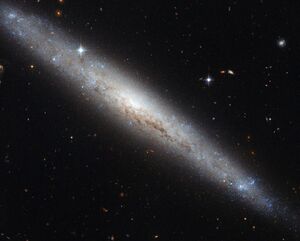Astronomy:NGC 4183
From HandWiki
Short description: Galaxy in constellation Canes Venatici
Coordinates: ![]() 12h 13m 16.860s, +43° 41′ 53.77″
12h 13m 16.860s, +43° 41′ 53.77″
| NGC 4183 | |
|---|---|
 Picture of NGC 4183 created from visible and infrared images taken with the Wide Field Channel of the Advanced Camera for Surveys. | |
| Observation data (J2000 epoch) | |
| Constellation | Canes Venatici[1] |
| Right ascension | 12h 13m 16.860s[2] |
| Declination | +43° 41′ 53.77″[2] |
| Redshift | 0.003105[2] |
| Helio radial velocity | 929 km/s[2] |
| Distance | 55 million light years[1] |
| Group or cluster | Ursa Major Cluster |
| Characteristics | |
| Type | Sc[2] |
| Size | 80,000 ly (diameter) |
| Apparent size (V) | 6.39 x 0.39 |
| Other designations | |
| MCG+07-25-051, UZC J121317.0+434153, [CHM2007] LDC 867 J121316.86+4341537,
FGC 1386, 2MFGC 9620, Z 215-53, LEDA 38988, RFGC 2222, Z 1210.7+4358, 2MASX J12131686+4341537, UGC 7222, [CHM2007] HDC 706 J121316.86+4341537 | |
NGC 4183 is a spiral galaxy with a faint core and an open spiral structure located about 55 million light-years from the Sun. Spanning about eighty thousand light-years, it appears in the constellation of Canes Venatici. NGC 4183 was observed for the first time by British astronomer William Herschel on 14 January 1788.
The galaxy is part of the Ursa Major Cluster.[3]
One supernova has been observed in NGC 4183: SN 1968U (type unknown, mag. 14.5).[4]
References
- ↑ 1.0 1.1 "Hubble portrays a dusty spiral galaxy". ESA/Hubble Picture of the Week. http://www.spacetelescope.org/images/potw1239a/.
- ↑ 2.0 2.1 2.2 2.3 2.4 "Search Results for NGC 4183". Astronomical Database. SIMBAD. http://simbad.u-strasbg.fr/simbad/sim-basic?Ident=NGC+4183.
- ↑ "The Ursa Major Groups". http://www.atlasoftheuniverse.com/galgrps/uma.html.
- ↑ Transient Name Server entry for SN 1968U. Retrieved 29 March 2023.
External links
 |

